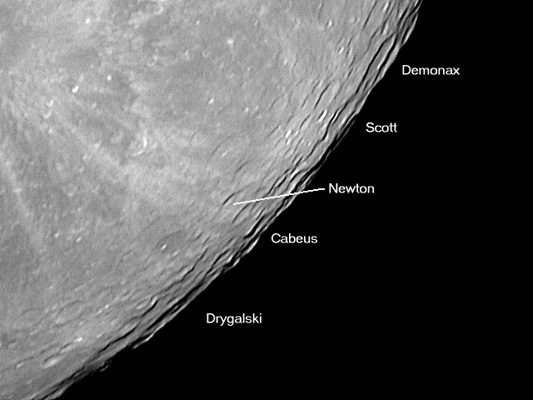Difference between revisions of "January 5, 2004"
| Line 41: | Line 41: | ||
[http://webcaddy.com.au/astro/adapter.htm Moog Webcam Adapter]</p> | [http://webcaddy.com.au/astro/adapter.htm Moog Webcam Adapter]</p> | ||
<p><b>Yesterday's LPOD:</b> [[January 4, 2004|Rising Moon]] </p> | <p><b>Yesterday's LPOD:</b> [[January 4, 2004|Rising Moon]] </p> | ||
| − | <p><b>Tomorrow's LPOD:</b> [[January | + | <p><b>Tomorrow's LPOD:</b> [[January 6, 2004|Gores of the Moon]] </p> |
<!-- bottom --> | <!-- bottom --> | ||
</td> | </td> | ||
Revision as of 12:24, 1 February 2015
South Polar Wilderness
|
|
|
South Polar Wilderness Most observers point their telescopes at the mare regions of the Moon - and part of the reason is that it is far easier to find things there! The further you get from the maria, the more the Moon appears as a wilderness of crater piled upon crater. One of the most difficult regions to find your way around is near the lunar south pole. Brian Jeffrey explored this area at full Moon on Feb 16, 2003 when the terminator slid around from the west, passed the pole, and moved to the east. His technical details suggest that the south pole may be less confusing than modern imaging techniques! Technical Details: Related Links:
Yesterday's LPOD: Rising Moon Tomorrow's LPOD: Gores of the Moon |
Author & Editor:
Charles A. Wood
Technical Consultant:
Anthony Ayiomamitis
A service of:
ObservingTheSky.Org
Visit these other PODs:
Astronomy | Mars | Earth
COMMENTS?
Register, and click on the Discussion tab at the top of the page.
Contributions to http://www2.lpod.org/ are licensed under a Creative Commons Attribution No-Derivative-Works Non-Commercial 3.0 License. 




